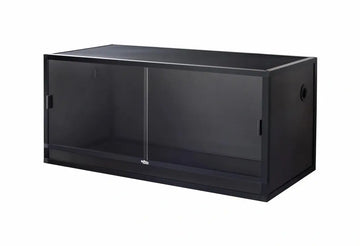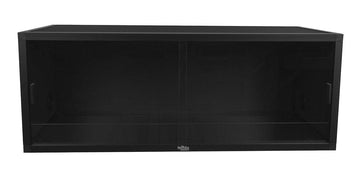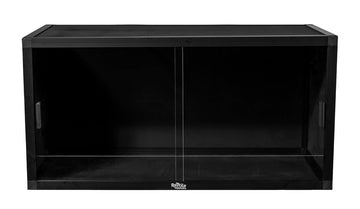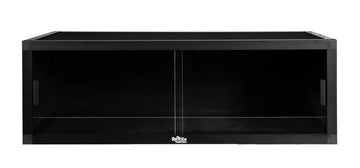Table of Contents
Introduction
Russian tortoises (Testudo horsfieldii) are a 5-8” long species of tortoise native to central Asia. Their common name is a bit of a misnomer, as they are uncommon in Russia, and more often found in Afghanistan, Pakistan, Iran, China, Kazakhstan, and Uzbekistan. They can be found in sandy steppe areas with sparse vegetation, particularly grass areas near springs of water.
Russian tortoises generally have a light tan to olive-colored shell with dark blotches, and a blotched or solid black plastron. The shell is oval-shaped with flattened vertebral scutes. Interestingly, they only have four toes on each forefoot. Females are generally larger than males.
Russian tortoises are one of the most common pet tortoises in the US. With good care, they are capable of living 50+ years!
Enclosure
Minimum terrarium size for Russian tortoises
The minimum acceptable enclosure size for a Russian tortoise is 12 sq feet of floor space. Since tortoises are poor climbers, floor space is the most important dimension to pay attention to. Because Russian tortoises prefer a drier habitat and are typically brought home at around 4”, they can do well in “tortoise table” style indoor enclosures as long as they have humid retreats.
Can Russian tortoises be kept in an outdoor pond?
Yes! If your local climate and housing situation allows, Russian tortoises tend to do best when housed in an outdoor pen for at least part of the year. If this is a possibility for you, make sure that the pen offers at least 36 sq ft of space to roam. The pen must offer areas of both sunlight and shade, and has a concrete foundation to prevent the tortoise from escaping. It also must be enclosed by a secure fence to prevent escape, plus anti-predator measures to protect against birds.
Your tortoise may need to be brought indoors for the winter, depending on its subspecies and your local climate. Winter temperatures in your area that drop below 50°F means indoor housing is needed. In this case, make sure you are familiar with appropriate hibernation procedure and have a temporary winter enclosure on hand.
Can you keep two Russian tortoises together?
Maybe. Cohabitation (housing multiple tortoises in one enclosure) is best avoided with Russian tortoises, unless you have a large outdoor pen to help prevent territorial conflicts. When tortoises are housed in an enclosure that doesn’t have enough space for them to get away from each other, the likelihood of violent conflict is increased.
However, Russian tortoises are not a social species, and are perfectly happy living singly.
How to quarantine a Russian tortoise
Note that it’s best to quarantine your tortoise first. Whether your pet is wild-caught or captive bred, quarantine is still important. Quarantine is the practice of keeping an animal isolated and under sterile conditions in order to reduce the potential spread of disease.
Even if you don’t have other reptiles that could potentially get infected by anything the tortoise might be carrying, maintaining quarantine conditions for at least the first 3 months will enable you to more easily monitor for concerning symptoms and more easily treat them as well. You can do this with the same enclosure that you plan to keep the tortoise in long-term, or you can do this with a plastic tub or stock tank. As long as they are set up appropriately, these alternatives can make appropriate short-term quarantine housing.
Some rules for successful Russian tortoise quarantine:
- Keep the tortoise in a separate room from other reptiles.
- Do not use the same equipment for the new tortoise as for your other reptiles.
- Fully disinfect the enclosure weekly.
- Get the tortoise checked by an experienced reptile veterinarian and treated for parasites if needed.
- Observe for symptoms of disease or illness
A Russian tortoise should be completely healthy before being transferred out of quarantine to its long-term setup.
Lighting
Do Russian tortoises need UVB?
Yes, a moderate level of UVB lighting is required for Russian tortoises to maintain good health. The best UVB bulbs for Russian tortoises are:
- Arcadia T5 HO 12%
- Zoo Med T5 HO Reptisun 10.0
When the bulb is mounted in a Zoo Med Reptisun T5 HO Terrarium Hood fixture without mesh obstruction, it should be placed 6-8” above the top of the tortoise’s shell in the basking area. Bulbs mounted in the Arcadia ProT5 fixture can be placed further away: 15-24” above the tortoise’s shell. This also creates a wider area of UVB exposure.
Your UVB bulb and fixture should be roughly half the length of the tortoise’s enclosure, and left on for 14 hours/day during summer, and 10 hours/day during winter. However, if your tortoise is housed outdoors and has access to sunlight, you will not need a UVB lamp.
How to measure UVI
The strength of a lamp’s UVB output is measured in UV Index, or UVI. Coincidentally, this is the same measurement that the World Health Organization uses to measure risk of skin damage from exposure to solar radiation. The best way to measure UVI in your tortoise’s enclosure is with a Solarmeter 6.5.
To use the Solarmeter, hold the device vertically at the height of the basking surface, with the lens pointing directly up at the lamp. Russian tortoises should have a basking UVI between 3.0-4.0, with UVI everywhere else in the enclosure being lower. Although there is a basking distance recommended in the previous section, note that factors such as the density of your terrarium mesh as well as the exact hood you’re using for your UVB lamp will affect the exact distance needed.
Other lighting requirements
As a diurnal species, Russian tortoises need more illumination than what they get from just a UVB lamp. Bright light helps increase activity and appetite. To better simulate the brightness of sunlight, it’s best practice to also install a ~6500K LED or T5 HO fluorescent lamp to span most of the enclosure’s length. This also nourishes any live plants you may be using.
Heating
Best temperature for Russian tortoises
Like other reptiles, Russian tortoises are cold-blooded, which means that they rely on external temperatures to manage their own body temperature and metabolism. A reptile’s enclosure should offer a range of temperatures to allow them to thermoregulate effectively.
Specifically speaking, Russian tortoises should have a basking temperature around 95°F. Ambient temperatures should be between 70-80°F. Nighttime temperatures should be maintained between 70-75°F.
Artificial heating is not needed for Russian tortoises kept outdoors in an appropriate climate.
Best way to heat your Russian tortoise
There are many options for heating a tortoise enclosure: incandescent bulbs, halogen bulbs, red bulbs, blue bulbs, mercury vapor bulbs, ceramic heat emitters, etc. Which one is best for your pet? Does it matter?
It does, in fact.
According to experts, the best way to heat a reptile is with technology that most closely replicates the way the sun provides heat: halogen flood bulbs. Provide heat for your Russian tortoise with a cluster of at least two halogen flood heat bulbs placed close together. Avoid using other options, as these are less effective at providing basking heat and may negatively affect your pet’s health.
Heat lamps should be placed at least 8” away from the top of your tortoise’s shell for even heating and to reduce the risk of burns. Higher-wattage heat bulbs may be needed to compensate for additional distance.
How to measure terrarium temperature
Measure temperatures with a couple of digital probe thermometers. One probe should be placed on the basking surface, and the other probe should be placed on the cool side of the enclosure. With the readouts from both of these devices, you will be able to monitor your pet’s temperature gradient at a glance. Note that due to the tortoise’s movements, you will likely need to fix the placement on the probes on a regular basis to continue to get accurate readings.
If you notice that your basking temperatures are too warm, dial down the bulbs’ heat output with a rheostat. If they are too cool, you will need higher-wattage bulbs.
Humidity
Best humidity levels for Russian tortoises
Russian tortoises need a humidity gradient from 40-75%. Humidity will be lower in the basking area and higher in the shaded/cool area. It will also be lower during the day than at night. This can be accomplished by providing a humid hide on the cool side. Humidity should be monitored via digital probe hygrometer, with the probe placed in the middle of the enclosure.
Increase humidity by wetting down the cool side of your tortoise’s enclosure daily to every other day with a spray bottle. In the case of an outdoor enclosure, use a hose sprayer on the shady side of the setup.
How to create a humid hide for your Russian tortoise
The humid hide functions like a humid burrow or hollow log to which the tortoise can retreat when they feel the need for a bit of extra moisture. Considering that wild Russian tortoises spend a significant amount of their lives in these humid microclimates, having access to a humid hide is essential to maintaining a well-hydrated tortoise with a smooth shell.
You can either purchase a humid hide or make your own. Most commercial options for humid hides are too small for a Russian tortoise, but the XL Exo Terra Reptile Cave and Exo Terra Tortoise Cave. These products are attractive and easy to clean. However, to DIY your own humid hide, use an upside-down plastic tub with a hole cut out for an entrance. Either way, line the hide with moistened paper towel or moistened substrate to create the right climate.
Substrate
Best substrate for Russian tortoises
Providing a thick layer of naturalistic substrate (“bedding”) will help maintain correct humidity levels and also provide something for your tortoise to dig in as desired. We recommend the following substrates for Russian tortoises:
Plain topsoil mixed 60/40 with play sand also works well.
Substrate should be at least 8” deep and completely replaced every 6 months. Remove poop and urates daily, along with contaminated substrate.
Does sand give Russian tortoises impaction?
Substrate is a controversial topic when it comes to tortoises, because there’s a popular myth that loose substrate will cause gut impaction and potentially kill the tortoise. This is why larger-particle substrates like bark and mulch are popular with this species. However, it’s more consistent with their biology for them to be housed on something that resembles their wild habitat.
The truth is that only unhealthy, dehydrated tortoises with inappropriate husbandry are in true danger of substrate impaction. Otherwise, they would be dropping dead left and right in the wild, because their substrate in nature is largely sand or sandy soil. They occasionally ingest a small amount of substrate by accident, but a healthy tortoise should be able to pass it through their digestive tract with no complications. Intentionally ingesting large amounts of substrate is a sign of illness and requires veterinary attention.
That being said, it’s best practice to minimize substrate ingestion. The best way to do this is by only serving food on a plate or shallow dish, not directly on top of the substrate.
Avoid sand substitutes at all costs! This includes calcium sand, vitamin sand, crushed walnut, etc!
What to know about cleaning a Russian tortoise enclosure
Replacing the tortoise’s substrate is a good time to give the entire enclosure a good cleanout. Here are some general steps to follow:
- Remove your tortoise from the enclosure and put it inside a temporary, escape-proof holding container.
- Remove all substrate and décor.
- Vacuum and wipe down the enclosure to remove leftover particles.
- Apply a reptile-safe disinfectant to the floor and walls of the enclosure and let sit for the disinfectant’s recommended contact time.
- Meanwhile, soak branches, rocks, hides, and other decor in a disinfectant rated for porous materials for the recommended contact time.
- If required, rinse the enclosure and the accessories with clean water to remove disinfectant residue. Allow everything to dry.
- Pour new substrate into the enclosure. Mix in water until uniformly moistened but not wet.
- Arrange décor.
- Reintroduce your pet to the clean setup.
Some veterinary-grade disinfectant options that work for both porous and nonporous materials are F10SC, CleanBreak, and bleach solution. However, for porous materials, bleach solution should be in a 1:10 dilution, while you should use 1:50 for nonporous.
Can bioactive work for Russian tortoises?
Absolutely. This is essentially the default for outdoor pens, but you will need to put a little bit more work in for indoor pens and enclosures.
Bioactive setups can be a good choice of housing for Russian tortoises because they are better at maintaining appropriate humidity levels in dry climates, and are generally more attractive than other options. They also offer the additional benefit of eliminating the need for total cleanouts, and a healthy bioactive setup always has a fresh, earthy aroma.
Some downsides of bioactive for Russian tortoises are that they require at least one month to get established before the animal is introduced, the plants that you use need to be sturdy enough not to get crushed, and bioactive is usually more expensive to set up in the short-term. CUC (Clean Up Crew) organisms may occasionally escape, and maintenance in the form of plant care and occasional partial soil replacements are still necessary. Given that tortoises are herbivorous, expect to have to occasionally replace the plants in their enclosure.
If you want to put together an indoor bioactive setup for your tortoise, you will need all of the supplies recommended in this article, plus a few more things:
- bioactive-ready semi-arid substrate mix
- clean leaf litter
- edible, drought-tolerant live plants
- CUC organisms to maintain the soil
While it’s possible to mix your own semi-arid bioactive substrate, if this is your first attempt at bioactive, you’re most likely to have success if you use a pre-mixed bioactive substrate available commercially, such as through Bio Dude or Josh’s Frogs.
Good options for CUC for a bioactive Russian tortoise enclosure include: dwarf white isopods, powder orange/blue isopods, springtails, mealworms, superworms, and buffalo beetles.
Décor
How to decorate a Russian tortoise enclosure
An empty terrarium makes for a bored tortoise, reducing its quality of life. Keep your pet entertained and engaged with its environment with the strategic use of décor items that encourage it to exercise natural behaviors!
Here are some ideas to get you started:
- additional hiding places/burrows
- large hollow logs
- live, edible plants
- large, flat stones
The more stuff you add, the more functional your enclosure is likely to become! As an additional feature, you can shape the substrate into hills to create more environmental variety for your pet.
Live plant options for Russian tortoises
Because Russian tortoises are heavy-bodied and somewhat clumsy, they easily crush live plants in their enclosure. This means that you need to be careful in selecting plants that are the most likely to resist occasional trampling. That being said, the plants are almost guaranteed to get periodically grazed down, so replacement will be part of your routine maintenance strategy.
Here are some plants for Russian tortoises:
- Aloe
- Carex grass
- Echeveria
- Elephant feed
- Festuca grass
- Gasteria
- Haworthia
- Jade plant
- Mexican feather grass
- Opuntia (spineless variety)
- Sansevieria
- Sempervivum
Larger, older plants are more expensive to buy, but they are also sturdier and more likely to survive your tortoise. You can also try growing your own tortoise-safe plants with a specialty tortoise seed mix!
Food
What to feed to a Russian tortoise
Russian tortoises are herbivores, which means that they need a high-fiber, plant-based diet to stay healthy. Variety is key to good nutrition, but most of your Russian tortoise’s diet should be an assortment of leaves and grasses, with occasional flowers.
Safe greens for Russian tortoises include: cactus pads, kale, collard greens, turnip greens, mustard greens, dandelion greens + flowers, hibiscus leaves + flowers, nasturtium, alfalfa, clover, coreopsis, geranium, grape leaves. If fresh flowers aren’t available, dried flowers like Zoo Med Tortoise & Box Turtle Flower Food Topper can be sprinkled on top of the salad.
Russian tortoises can also eat grass and grass hay! Try bluegrass, Bermuda grass, timothy grass, rye grass, and fescue grass.
Food should be offered on a paper plate or shallow dish in order to minimize substrate ingestion.
What treats can you give to a Russian tortoise?
Fruit should be only used as a treat, and in small quantities due to its high sugar content. Appropriate fruits include apples, berries, melons, papaya, guava, pineapple, bananas, cactus fruit, grapes, plums, and peaches.
Do Russian tortoises need vitamins?
You will also need calcium and vitamin supplements to prevent your tortoise from developing a potential deficiency. For vitamins, we recommend Repashy Superveggie, lightly dusted on each meal. A little bit of moistened Mazuri tortoise diet or Zoo Med Natural Grassland Tortoise Food also makes a nutritious addition.
For calcium, you will need a cuttlebone. Make sure to remove the plastic backing before using. The cuttlebone can be left whole in the enclosure for the tortoise to gnaw on, which helps keep its beak filed down. Expect to go through one cuttlebone every 1-2 months.
Providing drinking water for Russian Tortoises
Of course, don’t forget a water bowl! Russian tortoises like to soak, so you will need a shallow “puddle” of water for them to soak and defecate in. Use a flower pot saucer or similar for this purpose. Change the water daily and scrub the dishes weekly with a reptile-safe disinfectant, or whenever it becomes soiled.
Handling
How to handle your Russian tortoise
Reptiles generally don’t appreciate petting and handling in the same way that dogs and cats do. That being said, Russian tortoises generally tolerate human interaction pretty well! If you have to pick up your tortoise, be gentle and try to pick it up from the side or below rather than from above. They tend to appreciate gentle scratches and hand-feeding.
Taming tips for Russian tortoises
Tortoises are generally perceived as calm and gentle, so they’re often also perceived as easy to tame as well. However, this isn’t always the case. Even if you have a calm tortoise, you still have to work to gain their trust, and be especially careful to create a positive association with yourself in their mind. It’s best to encourage your pet to come to you on their own, rather than chasing them around. Never grab a reptile out from its hiding place, as this is a very effective way to make it feel unsafe.
Treats and hand-feeding are very effective for teaching your tortoise that you are not something to be feared, since hunger can motivate your pet to move outside of its comfort zone. Flowers make excellent healthy treats! Use soft-tipped feeding tongs to prevent getting bitten by accident if you’re worried about that.
How to provide enrichment to a Russian tortoise
Enrichment is the practice of strategically providing items and activities to encourage a captive animal to exercise natural behaviors. This also helps increase activity, reduce stress, and generally increase the animal’s welfare.
Some argue that reptiles are “too dumb” to benefit from enrichment, but this is false. All reptiles can absolutely benefit from enrichment when it is provided in appropriate ways. Here are some ways to provide enrichment for Russian tortoises:
- Rearrange the enclosure. If total overhauls are too stressful, move one thing every so often at your tortoise’s pace. For some individuals, that may be once a month, for others they might like once a week.
- Puzzle feeders. Try putting a piece of fruit in a puzzle feeder or hanging a bouquet of greens from the ceiling!
- Scatter feeding. Rather than offering all of their food in one bowl, try putting it in various places around the enclosure. Make sure to keep the food off the substrate, wherever you put it.
- Supervised explore time outside of the enclosure. Make sure to keep them away from situations that you can’t get the tortoise out of, and be particularly careful if you want to take them outside. For outdoor excursions, it’s best to use a pen to prevent them from running off.
Health
When should you take a Russian tortoise to the vet?
Dogs and cats aren’t the only pets who need veterinary care — tortoises get sick and need professional help the same as any other pet. If you notice that your pet has any of the following symptoms, make an appointment with an experienced reptile vet right away:
- Unexplained weight loss
- Loss of appetite
- Intentional substrate ingestion
- Open wounds
- Discharge from the eyes, nose, or mouth
- Discolored urate
- Shell discoloration
- Shell softening
- Unusual shell texture/shape
- Swelling or bumps anywhere on the body
- Lethargy
- Twitching
- Overgrown beak
You can find a reputable reptile vet near you with the ARAV Find a Vet tool.
*This care sheet contains only very basic information. Although it’s a good introduction, please further your research with high-quality sources. The more you know, the better you will be able to care for your Russian tortoise!











